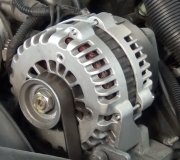Hold on a minute. Nothing you have said so far indicates there is a charging system problem. There is no way you would drive for a week if the charging system was gone. At most, you would get an hour if the heater fan and head lights were never used.
You can have an intermittently-bad charging system when the alternator's brushes are worn and making intermittent contact, but that does not last long before the failure becomes permanent. The brush assemblies on Chrysler alternators are pretty easy to replace, but you already took care of that possibility with a replacement alternator.
The first thing you need to do is verify the charging system is working properly. With the engine running, use an inexpensive digital voltmeter to measure the battery's voltage. You must find between 13.75 and 14.75 volts. If the charging system is not charging, you will find 12.6 volts or less.
The next step is to read and record any diagnostic fault codes, but in this case, they were all erased when the battery was disconnected, so all that valuable information was lost. To add to the misery, fault codes for the two best suspects often do not set just from cranking the engine. They set while a stalled engine is coasting to a stop. That means do not assume anything about these two sensors just because there is no fault code related to them.
Those sensors are the crankshaft position sensor and the camshaft position sensor. Either one can fail intermittently, and that will cause engine stalling. In this application, the camshaft position sensor is the most common suspect.
You also did not say what it takes to get the engine restarted, and how long that takes. Cam and crank sensors often fail by becoming heat-sensitive, then they work again after cooling down for about an hour. The most common scenario is the engine runs fine, but then will not restart right after a short stop, as in when stopping for gas. While driving, natural air flow keeps the sensors cool. When a hot engine is stopped, "hot soak" allows engine heat to migrate up to the sensors, causing them to fail. An hour to cool down and start working gain is usually enough time.
Tuesday, December 26th, 2017 AT 3:32 PM



